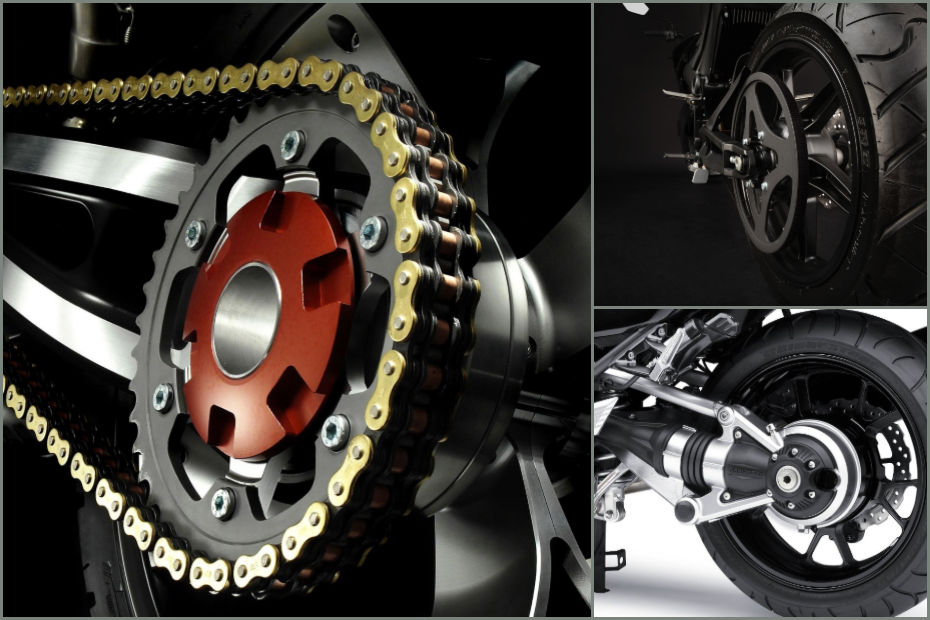Different Types Of Motorcycle Drive Systems
Modified On Jun 8, 2019 11:56 AM By Gaurav Sadanand
- 3847 Views
- Write a comment
We take a closer look at all the systems motorcycles use to transfer power from the engine to the rear wheel.

Chain drives are the most commonly used drivetrain systems on bikes. They can be seen on motorcycles ranging from everyday commuter motorcycles to litre-class bikes pushing speeds north of 300kmph. But that’s not the only way of transferring power to the rear wheel - two-wheeler manufacturers also use a belt or shaft drives on certain types of bikes. So, how do these three configurations differ? And why does one hold a monopoly in the two-wheeler market? To answer these questions we take a closer look at each one of them and weigh their advantages and disadvantages. Let’s start off with..
Chain Drive:

A chain drive system uses three crucial components - two sprockets (small & large) and a chain (usually O ring or X ring) wrapped around it. Simply put, when the transmission spins the smaller sprocket, it transfers power via the chain to the larger rear sprocket. And voila, your bike starts moving!
A chain drive is cheap to manufacture, easy to replace and has a compact form factor compared to the other drive systems. It’s also highly efficient and only eats around 3-4 per cent of the power transferred from the engine. Of course, this also depends on how well you lubricate and maintain the chain assembly. Last, but not least, a chain drive can operate in extreme conditions and handle insane amounts of power and torque.
On the flipside, it requires the most amount of maintenance. They are noisy, tend to wear out faster, start slacking after long intervals and requires periodic replacement (approximately every 25,000km). You’d also need to clean and lubricate your bike’s chain every 500-800km as they’re prone to gathering dirt and grime, which in turn reduces their life. There’s also the issue of corrosion, especially in certain climates, and if the chain isn’t tightened regularly, it can lead to the sprocket teeth wearing down rapidly, which can cause a nasty play in the sprockets. Also, on the rare occasion that a chain chews up a sprocket and snaps, it can lead to a rear wheel lockup, which could end in disaster.
Belt Drive:

Belt drives are usually seen on most cruisers, scooters and a couple of old sportbikes like the Buell 1125R and the BMW F800S. They use two pulleys and a belt made out of cogged rubber and functions more or less like a chain drive. Thanks to its rubber construction, it makes less noise and is smoother to run too. What’s more, it doesn’t need periodic maintenance as well. In fact, belt drives, if looked after properly, can last up to 90,000km or more!
However, thanks to big pulleys that run the drive belt, you won't necessarily find them on smaller, more compact bikes. It’s not easy to replace either and normally require removing the swingarm. Belt drives are also prone to stretching or slippage on high powered motorcycles, especially when there’s a sudden burst of torque, which can lead to a power loss of around 11 per cent.
Shaft Drive:

A shaft drive is quite complex and is most frequently used by BMW Motorrad. As the name suggests, it uses a shaft drive to power the rear wheel - somewhat like front-engine, rear-wheel drive cars. They require less to no maintenance, aren’t affected by rain, dust or dirt, and last a lifetime.
On the contrary, a shaft drive is expensive to manufacture and replace, and adds quite a few extra kilos to the bike's weight. While there’s no transfer loss, the system is less efficient as the engine needs to spin up a heavy shaft in order to transfer power to the rear wheel. This results in a massive power loss of up to 25 per cent at the crank.
To conclude, while all three drive systems have their own pros and cons, a chain drive is the most efficient and economical way to transfer power to the rear wheel of a motorcycle.
